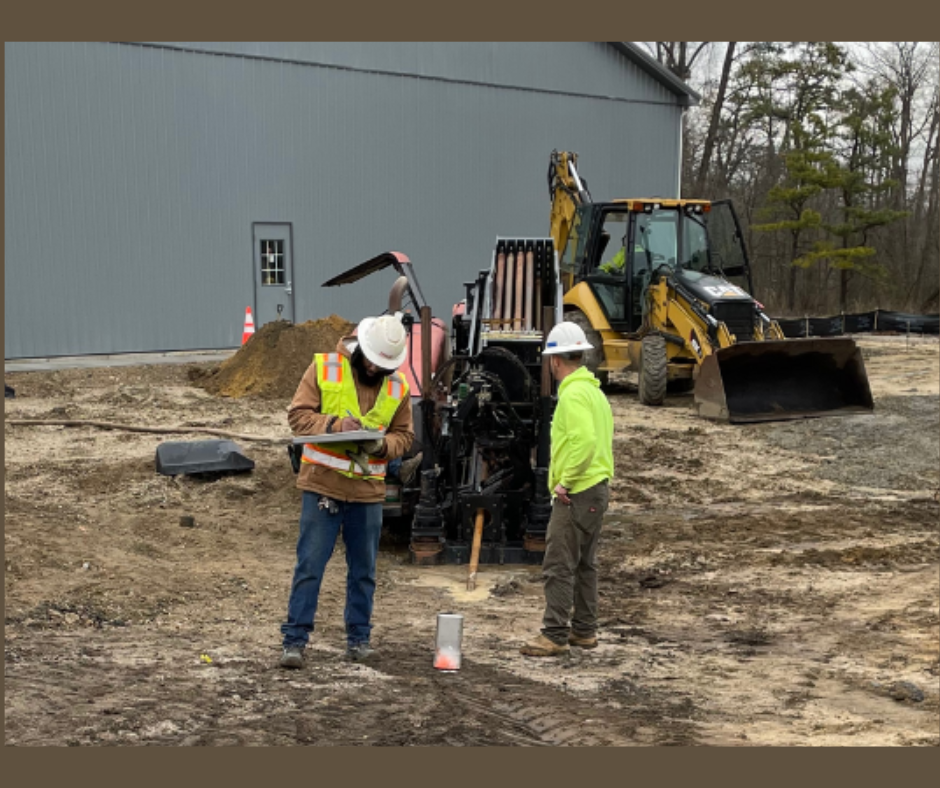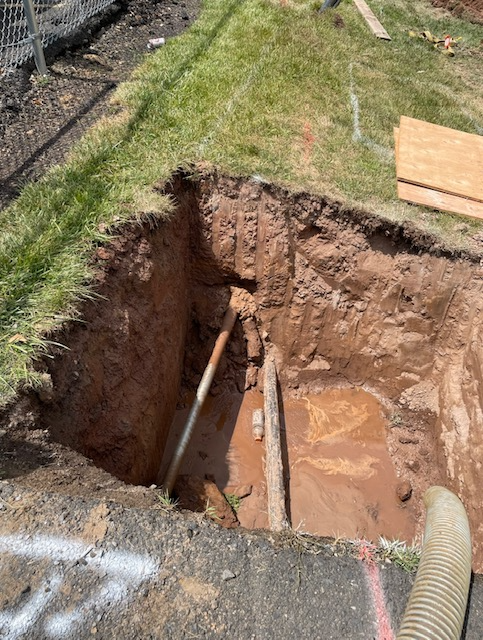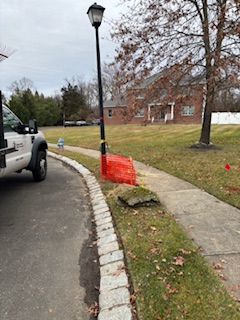Our Blogs

In today’s fast-paced infrastructure landscape, utility locating isn’t just a helpful step—it’s an essential safeguard that protects people, property, and the systems that keep our communities running. From electric and gas to telecommunications and water, underground utilities form an intricate network beneath our feet. Accurately identifying these lines before excavation or construction is critical to maintaining project efficiency, safety, and compliance. Let’s take a look at why utility locating is so important to the utility industry—and the risks organizations face when they skip this crucial step. 1. Protecting Public Safety Safety is the number one reason why utility locating is so important to any job. Striking a buried utility line can lead to dangerous, even life-threatening, situations. Damaged gas lines can cause explosions. Severed electrical lines can pose serious shock hazards, and compromised water or sewer lines can create environmental risks. Accurate locating ensures crews can work with confidence, knowing the ground beneath them is properly mapped out. This not only protects utility workers but also safeguards nearby residents, motorists, and businesses. 2. Preventing Costly Damage and Delays Hitting an underground utility doesn’t just stop work—it can halt entire projects. Repairs, service interruptions, fines, and rescheduling all add up quickly. According to industry estimates, damage to utility infrastructure costs billions each year in the U.S. alone. Utility locating dramatically reduces these risks by giving crews a clear understanding of what lies below. When contractors can avoid unexpected obstacles, projects stay on schedule and within budget—reducing downtime and keeping customers satisfied. 3. Supporting Reliable Service for Customers Every damaged line has a ripple effect. Whether it’s a neighborhood losing electricity, a business losing internet, or a community dealing with water outages, utility disruptions impact daily life. By identifying and protecting these lines during construction or utility repair work, utility locating helps maintain consistent service across entire communities. This reliability supports customer trust, strengthens utility-provider relationships, and prevents the headaches involved in emergency service calls. 4. Ensuring Regulatory Compliance Utility locating isn’t optional—it’s required. Federal and state regulations mandate that contractors contact local “One Call” systems (like 811 ) before digging. Organizations that fail to follow these rules risk hefty fines, legal liability, and project shutdowns. Professional locating helps contractors meet compliance standards, provide documentation, and demonstrate due diligence. It’s a proactive way to avoid penalties while maintaining a high standard of operational responsibility. 5. Improving Project Planning and Efficiency A well-planned project starts with accurate information. Utility locating offers detailed maps and insights that help teams design smarter, dig safely, and avoid unnecessary excavation. With the right data, utility contractors can: Adjust equipment selections Modify trench paths Optimize timelines Reduce rework Improve coordination across trades This streamlined workflow boosts productivity and leads to better outcomes for everyone involved. 6. Protecting the Integrity of Utility Infrastructure Utility networks continue to expand as new development rises—and that means existing lines are more vulnerable than ever. Locating prevents accidental damage and preserves the integrity of critical infrastructure, allowing utilities to operate effectively for decades to come. By protecting these systems, utilities reduce long-term maintenance costs and help create more resilient communities. A Small Step With a Big Impact In the utility industry, the importance of utility locating cannot be overstated. It’s a simple step that plays a massive role in safety, cost control, uptime, and regulatory compliance. Whether for repairs, new construction, or preventive maintenance, locating is the foundation of responsible, efficient utility work. When contractors and utility providers prioritize locating, they protect their crews, their communities, and the essential systems everyone relies on.

Winter in the Mid-Atlantic is unpredictable. Sudden freezes, heavy snow, and ice storms bring harsh conditions that directly affect the utility systems we rely on daily. For utility professionals, winter is a stress test for infrastructure, equipment, and field crews. At Delaware Valley Utility Contractors (DVUC), we know it’s vital to keep water, sewer, electrical, and gas systems running safely and efficiently during the harshest weather. Here’s how winter affects utilities and why preparation matters. 1. Freezing Temperatures Increase the Risk of Pipe Damage When temperatures plummet, water expands as it freezes. This pressure can cause water and sewer pipes—especially older or uninsulated lines—to crack or burst. Utility crews often see: Water main breaks Service line failures Frozen meters Reduced flow or pressure across systems The result? Emergency repairs, service disruptions, and significant costs for municipalities and utility providers. Proactive measures, such as insulation upgrades, heat tracing, and timely pipe replacement, help minimize cold-weather failures. 2. Snow and Ice Complicate Access to Utility Infrastructure Even minor snow or ice accumulation can create major challenges for utility crews. Buried markers become hidden, manholes and valves freeze over, and service areas may be blocked by ice-covered roads or mounds of snow. These conditions slow down: Routine inspections Emergency repairs Heavy equipment movement Crew response times At DVUC, strategic planning and proper snow-access equipment ensure crews can reach critical infrastructure quickly when every minute counts. 3. Increased Strain on Power Systems Winter storms often bring high winds, ice buildup, and heavy snow—three factors that directly threaten power infrastructure. Ice accumulation on power lines adds weight that can cause sagging or snapping. Strong winds can topple branches and damage poles. Heavy snowfall can also stress overhead structures. This leads to: More frequent outages Hazardous downed lines Damage to transformers and equipment Higher demand for rapid restoration crews Utilities must stay prepared with winter storm response plans, proper vegetation management, and pole/line reinforcement strategies. 4. Ground Conditions: Slow Construction and Maintenance Work Frozen ground can be as challenging as concrete. It makes excavation, trenching, and utility installation slower, more labor-intensive, and sometimes unsafe without specialized equipment. Winter ground conditions can cause: Delays in utility installation or replacement projects Inaccurate dig markings due to shifting frost lines Longer project timelines and increased labor needs DVUC mitigates these challenges with advanced equipment, skilled crews, and strategic project scheduling to keep work moving year-round. We offer vacuum excavation to keep the project moving along. 5. Safety Risks Increase for Utility Crews Cold weather doesn’t just affect infrastructure—it affects the crews working to maintain it. Prolonged exposure to freezing temperatures, icy surfaces, and low visibility conditions creates safety hazards, including: Slips and falls Cold Stress Reduced dexterity when handling tools Difficult driving conditions Safety training , proper PPE, and careful planning are essential for protecting field teams throughout the winter season. 6. Storm Response Demands 24/7 Readiness When winter storms hit, utility-related emergencies rise dramatically. Burst mains, sinkholes, outages, and equipment failures require immediate attention. Utility contractors must maintain: On-call response teams Fully fueled and winterized equipment Clear communication channels with municipalities and utility providers Fast mobilization plans At Delaware Valley Utility Contractors, our crews are always prepared to respond quickly and safely—no matter the weather. Ask about our snow removal services! Why Winter Preparedness Matters Winter weather is inevitable, but disruptions don’t have to be. With proactive planning, proper equipment, and experienced utility contractors, municipalities and utility providers can protect their infrastructure and minimize downtime. As a trusted partner across the region, Delaware Valley Utility Contractors brings decades of expertise in underground utilities, emergency response, and infrastructure maintenance. Whether it’s a sudden freeze, heavy snow, or an unexpected storm, our team is ready to keep critical systems safe and operational all winter long. If you’d like help preparing your utility systems for the upcoming winter season or need a reliable contractor for emergency service, DVUC is here to help. Reach out today to learn more about our capabilities and commitment to safety and reliability.

In today’s digital world, data is the new currency — and data centers are the vaults that keep it safe, accessible, and constantly in motion. From streaming platforms and social media to artificial intelligence and cloud computing, data centers have become the backbone of modern life. But as these massive facilities multiply to meet global demand, one industry is feeling the impact more than most: the utility industry.

On behalf of the Empire Group , we would like to offer our sincere thanks to everyone who participated in our Annual Golf Classic on October 4 th at the beautiful Galen Hall Golf Club in Wernersville, PA. It’s hard to believe this marked the 30th year of the tournament! Although this was Empire Group's first time hosting the event at this historic venue, they have deep roots at Galen Hall — affiliate Empire Services demolished the original Galen Hall Hotel back in 1963 following a devastating fire. Since then, the golf club has remained a local landmark, known for its scenic views and welcoming atmosphere. Despite the cool early morning, 99 golfers were warmed up and ready for the 8 AM shot gun start leading to some fun but competitive golfing. After the final putt dropped, everyone gathered for the award ceremonies, followed by a hearty lunch. Shout out to the winners of all categories and the raffle!

In the heart of America’s urban infrastructure, manholes play a vital but often overlooked role. Beneath our streets, they serve as gateways to the complex web of utility lines—power, water, gas, telecommunications, and more. But in rare and dangerous cases, these silent sentinels become sites of catastrophic manhole gas explosions. At Delaware Valley Utility Contractors (DVUC), safety, reliability, and proactive utility maintenance are our top priorities. Understanding what causes manhole gas explosions—and how to prevent them—is crucial to protecting both utility workers and the public. What Causes Manhole Gas Explosions? Manhole explosions are not common, but when they happen, the consequences can be dramatic—blown-off covers, street damage, power outages, and severe injuries. The primary causes include: Accumulation of flammable gases: Methane , hydrogen sulfide , or volatile organic compounds (VOCs) can build up in underground utility vaults. Electrical faults or arcing: Faulty wiring or short circuits can ignite flammable gases. Poor ventilation: Without proper airflow, gas concentrations can reach dangerous levels. Improper disposal of chemicals or waste: Dumped gasoline, paints, or industrial chemicals can contribute to explosive conditions. Cable insulation breakdown: Aging or damaged cables can release gases or create sparks under stress. These incidents are not just spontaneous—they are the result of preventable system failures. Some Ways to Help Prevent Manhole Explosions At DVUC, our commitment to underground safety is unmatched in the region. Here’s how we help prevent these incidents: 1. Gas Detection and Monitoring Our teams are trained to use state-of-the-art gas detection equipment to identify and monitor hazardous gases in manholes before any work begins. 2. Routine Manhole Inspections We conduct thorough inspections of underground vaults, identifying corrosion, water intrusion, cable degradation, and other red flags. 3. Infrastructure Upgrades We help utilities modernize old or outdated cable systems with low-emission, fire-resistant materials—reducing the chances of insulation failure and gas release. 4. Ventilation & Degassing Solutions Our crews install and maintain active ventilation systems in high-risk locations, ensuring trapped gases don’t reach combustible concentrations. 5. Training & Emergency Preparedness At DVUC, worker safety is our top priority. Our crews are OSHA-certified, Hazmat-trained, and ready to respond to emergency situations with speed and precision. Signs of a Potential Manhole Hazard Be aware of early warning signs of underground gas buildup: Unusual odors (rotten egg, chemical, or burning smells) Smoke or steam escaping manhole covers Hissing or popping sounds from manhole areas Discoloration or corrosion around covers If you notice any of these signs, contact your local utility provider or emergency services immediately. Need Help with Manhole Inspections or Underground Utility Work? Delaware Valley Utility Contractors is ready to assist. Whether you're managing a city-wide utility system or handling private underground infrastructure, our team brings experience and expertise to every job. 📞 Contact us today to schedule a consultation or inspection. 📍 Serving the Greater Delaware Valley: Pennsylvania | New Jersey | Delaware | Maryland | New York

When it comes to building and maintaining underground utility systems, few partners are as trusted in the region as Delaware Valley Utility Contractors (DVUC). From water and sewer installation to electrical and telecom conduits, our work powers communities, businesses, and essential infrastructure across Pennsylvania, New Jersey, and the surrounding region. But who exactly needs utility contracting services? The answer may surprise you. DVUC serves a wide range of industries — each with its own unique needs and challenges. Let’s explore the key sectors that count on DVUC to keep operations running smoothly, safely, and efficiently. 1. Construction & Development Whether it’s a new residential neighborhood, a commercial building, or a mixed-use development, builders utilize DVUC to install underground utility systems before vertical construction even begins. Services we provide: Sanitary sewer & stormwater systems Water main installation Electric and gas conduit installation Site grading and excavation Our deep knowledge of local codes, commitment to safety, and ability to coordinate across multiple contractors make us a go-to partner from project start to finish. 2. Municipalities & Government Agencies Local governments turn to Delaware Valley Utility Contractors to support public works projects, infrastructure upgrades, and emergency repairs. Common projects: Water/sewer line replacements Roadway utility relocations Public utility improvements Traffic signal conduit installation Municipalities value our responsiveness, compliance with state and federal regulations, and experience working within tight budgets and timelines. 3. Commercial & Industrial Facilities Large facilities can’t operate without reliable utility systems. DVUC supports industrial plants, warehouses, and commercial campuses with custom underground utility solutions. Industrial services include: Fire suppression water line installation Stormwater drainage systems Electrical duct banks On-site excavation and trenching We offer turnkey solutions for large-scale, high-demand utility systems with minimal disruption to operations. 4. Telecommunications & Energy Providers The demand for broadband and clean energy continues to grow. DVUC helps telecom and energy companies expand their networks quickly and safely through expert directional drilling and conduit installation. Specialized services: Horizontal directional drilling (HDD) Fiber optic and electric conduit boring Vault and manhole installation Gas main construction Our precision drilling technology and ability to install utilities without open trenching make us an ideal partner for urban and environmentally sensitive areas. 5. Transportation & Infrastructure Projects Utility coordination is crucial in highway, bridge, and rail projects. DVUC works alongside engineering firms and department of transportations (DOTs) to handle underground utility relocation and protection during major transportation upgrades. Work typically includes: Utility mapping and location services Utility conflict resolution Trenching and backfilling Traffic signal infrastructure installation Our proven track record of coordinating with DOTs and managing complex site logistics helps avoid costly delays and ensures safety. 6. Utility Companies & Energy Cooperatives Utility providers need contractors who can install and maintain infrastructure with strict adherence to safety and performance standards. DVUC supports both public and private utility companies across the region. Key services: Gas, electric, and water main installation Subsurface utility engineering (SUE) Emergency repair response Long-term utility maintenance contracts Our highly trained crews and deep utility expertise ensure we deliver high-quality results, every time. Partnering with Delaware Valley Utility Contractors At DVUC, we understand that every industry has different utility needs. That’s why we offer customized solutions, safe job site practices, and unmatched regional experience across Eastern Pennsylvania, Delaware, New York, New Jersey, and Maryland. We have offices in Reading, PA and Long Branch, New Jersey. Ready to Get Started? Contact Delaware Valley Utility Contractors today to learn how we can support your next project with reliable, compliant, and cost-effective utility contracting solutions.

Does Summer Heat Threaten Underground Pipes? When the temperature climbs past 90°F, most of us worry about sunburn, air conditioning bills, and keeping our lawns green. But there’s a hidden risk you might not be thinking about – your buried pipes . Just because they’re underground doesn’t mean they’re protected from extreme weather. In fact, prolonged summer heatwaves can put serious stress on your buried water and sewer lines , leading to leaks, cracks, or even full-blown pipe failures. How Does Extreme Summer Heat Affect Buried Pipes? 1. Soil Shifting and Ground Movement One of the biggest dangers to buried pipes during a heatwave is drying soil . As soil loses moisture, it contracts and shifts. This movement can: Put pressure on pipes, causing them to crack or dislodge Create gaps where pipes were once supported Damage pipe joints and seals This is especially problematic for homes with clay-heavy or expansive soil, which is prone to shrinking during hot, dry spells. 2. Increased Water Demand Hot weather often leads to more water use — from lawn irrigation systems to swimming pool refills. This puts added stress on underground water supply lines , increasing the risk of leaks or ruptures, especially in aging infrastructure. 3. Thermal Expansion Although buried pipes are generally more insulated from surface temperatures, extreme and prolonged heat can still cause thermal expansion , especially in shallow or poorly installed pipes . This stress can lead to buckling, joint failure, or pipe bursts. 4. Root Intrusion Accelerates Believe it or not, tree roots grow more aggressively in the heat as they search for moisture, making your sewer lines and buried pipes prime targets , especially if there are small cracks or leaks already present. Once roots infiltrate, they can cause major blockages or even pipe collapse. Warning Signs of Damaged Underground Pipes You won’t always see underground pipe issues right away — but there are key warning signs to watch for: Unusually soggy or sunken spots in your yard A sudden spike in your water bill Foul odors near your lawn or garden (a sign of sewer leaks) Drop in water pressure Gurgling drains or frequent backups If you spot any of these, don’t ignore them — what’s underground won’t stay hidden for long. Some Ways on How to Protect Buried Pipes in Hot Weather ✅ Hydrate the Soil Around Your Foundation Keeping the soil evenly moist (but not overwatered) helps prevent excessive shrinkage and ground shifting. A soaker hose around your foundation can help stabilize soil moisture levels. ✅ Maintain Your Irrigation System Check for leaks or overwatering. Leaking irrigation lines not only release water but can contribute to soil erosion and added stress on your underground plumbing system. ✅ Consider Trenchless Pipe Repair or Replacement If your underground pipes are already damaged, you should check out utility companies about trenchless repair options . These minimally invasive techniques avoid tearing up your yard and are ideal for dealing with heat-related damage. Don’t Let Heat Sneak Up on Your Pipes Extreme summer heat is tough on everything — including your buried plumbing system. While these issues often stay out of sight, they can quickly lead to costly damage if ignored. The good news? With the right maintenance, early detection, and smart prevention, your pipes can stay strong all season long. At DVUC, we have the experience and expertise to handle residential water line issues or pipe emergencies. Contact us today to learn more!

Delaware Valley Utility Contractors, also known as DVUC, has built a reputation for excellence through its dedicated service to the utility industry over the years. DVUC offers a wide range of services, including verifying utility lines, installing new gas lines, unclogging storm drains, and repairing water mains. Did you know water main breaks are quite common in the United States, with an estimated 240,000 happening every year? Water mains are large pipes buried under sidewalks and roads that distribute water throughout the community. The water mains are connected to homes, apartments, facilities, and businesses by smaller pipes called water service lines. The MDOT Construction Manual states that water mains are pipes that are run under pressure to provide a continuous supply of water when performing tasks (e.g., washing dishes). Water mains transport water to major water uses in a community, whereas water service lines transport water within the community (e.g., homes). What are Water Main Breaks? What can happen to the water mains is that they can rupture, which is known as a water main break. A water main break is a crack or rupture in the pipe that allows the water to escape. Having a water main break can cause property damage, road closures, and expensive repairs. SEH Inc. states that water main breaks can happen for several reasons, including: ● Excavation work ● Pipe age and material ● Pressure changes ● Ground settling ● Corrosive soils During excavation work, homeowners and utility workers can unintentionally strike the water pipes with their equipment, causing the water to spill out. Older pipes tend to be brittle and are more likely to break. As a result of temperature changes (e.g., cold weather) or firefighters opening and closing fire hydrants quickly, pressure changes cause pipes to rupture. As soil settles around the water main, the pipes can become stressed or warped, resulting in their failure. Some soil is corrosive (capable of destroying other substances by causing a chemical reaction) and can cause pipes to deteriorate over time, causing them to burst. What Is the Impact? The impact of water main breaks depends on the size of the pipes, where they are located, and how they are connected to the rest of the water system. According to BedfordMA.gov , some of the impacts that could happen are: ● Erode soil and roads ● Sinkholes ● Flooding ● Traffic Problems ● Damaged Properties On July 6th, 2025, Kutztown University’s South Dining Hall’s water main broke. This break caused the dining hall to flood. Although Delaware Valley University did not have a water main break in November 2022, the facility needed a water main system upgrade due to the addition of new bathrooms. Delaware Valley University had contacted DVUC to get the job done. DVUC is no stranger to upgrading water main systems at Universities. What can DVUC do for you? Here at DVUC, we specialize in a wide range of utility services, no matter the complexity or scope of your project. DVUC’s field crew has the training, equipment, and experience to handle water main and water service issues. We strive to exceed your expectations! Our team understands that every project is unique, and we take pride in delivering flexible solutions tailored to your specific requirements.




